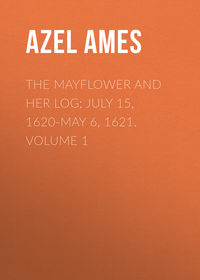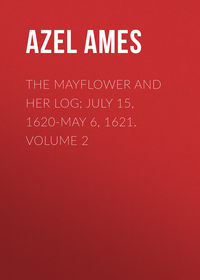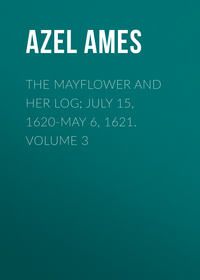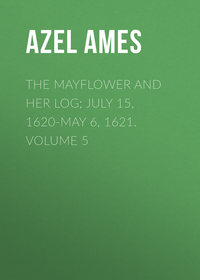 полная версия
полная версияThe Mayflower and Her Log; July 15, 1620-May 6, 1621. Volume 4
The possible accessions to the company, at London or Southampton, of Henry Sampson and Humility Cooper, cousins of Edward Tilley and wife, would be added to the passengers of the pinnace rather than to the MAY- FLOWER'S, if, as seems probable, their relatives were of the SPEEDWELL. If Edward Tilley and his wife were assigned to the MAY FLOWER, room would doubtless also be found for these cousins on the ship. John Alden, the only positively known addition (except Carver) made to the list at Southampton, was, from the nature of his engagement as "cooper," quite likely assigned to the larger ship. There are no known hints as to the assignments of passengers to the respective vessels at Southampton—then supposed to be final—beyond the remarks of Bradford that "the chief [principal ones] of them that came from Leyden went on this ship [the SPEEDWELL] to give the Master content," and his further minute, that "Master Martin was governour in the biger ship and Master Cushman assistante." It is very certain that Deacon Carver, one of the four agents of the colonists, who had "fitted out" the voyage in England, was a passenger in the SPEEDWELL from Southampton,—as the above mentioned remark of Bradford would suggest,—and was made "governour" of her passengers, as he later was of the whole company, on the MAY-FLOWER. It has sometimes been queried whether, in the interim between the arrival of the SPEEDWELL at Southampton and the assignment of the colonists to their respective ships (especially as both vessels were taking in and transferring cargo), the passengers remained on board or were quartered on shore. The same query has arisen, with even better reason, as to the passengers of the SPEEDWELL during the stay at Dartmouth, when the consort was being carefully overhauled to find her leaks, the suggestion being made that in this case some of them might have found accommodation on board the larger ship. The question may be fairly considered as settled negatively, from the facts that the colonists, with few exceptions, were unable to bear such extra expense themselves; the funds of the Adventurers—if any were on hand, which appears doubtful—were not available for the purpose; while the evidence of some of the early writers renders it very certain that the Leyden party were not released from residence on shipboard from the time they embarked on the SPEEDWELL at Delfshaven till the final landing in the harbor of New Plimoth. Just who of the Leyden chiefs caused themselves to be assigned to the smaller vessel, to encourage its cowardly Master, cannot be definitely known. It may be confidently assumed, however, that Dr. Samuel Fuller, the physician of the colonists, was transferred to the MAY-FLOWER, upon which were embarked three fourths of the entire company, including most of the women and children, with some of whom, it was evident, his services would be certainly in demand. There is little doubt that the good Elder (William Brewster) was also transferred to the larger ship at Southampton, while it would not be a very wild guess—in the light of Bradford's statement—to place Carver, Winslow, Bradford, Standish, Cooke, Howland, and Edward Tilley, and their families, among the passengers on the consort. Just how many passengers each vessel carried when they sailed from Southampton will probably never be positively known. Approximately, it may be said, on the authority of such contemporaneous evidence as is available, and such calculations as are possible from the data we have, that the SPEEDWELL had thirty (30), and the MAY-FLOWER her proportionate number, ninety (90)—a total of one hundred and twenty (120).
Captain John Smith says,
[Smith, New England's Trials, ed. 1622, London, p. 259. It is a singular error of the celebrated navigator that he makes the ships to have, in less than a day's sail, got outside of Plymouth, as he indicates by his words, "the next day," and "forced their return to Plymouth." He evidently intends to speak only in general terms, as he entirely omits the (first) return to Dartmouth, and numbers the passengers on the MAY-FLOWER, on her final departure, at but "one hundred." He also says they "discharged twenty passengers."]
apparently without pretending to be exact, "They left the coast of England the 23 of August, with about 120 persons, but the next day [sic] the lesser ship sprung a leak that forced their return to Plymouth; where discharging her [the ship] and twenty passengers, with the great ship and a hundred persons, besides sailors, they set sail again on the 6th of September."
[Dr. Ames, so stringent in his requirements of other authors, for example Jane Austin, has to this point been pathetically naive as to the opinions of Captain John Smith. Captain Smith's self-serving and very subjective narratives of his own voyages obtained for him the very derogatory judgement by his contemporaries. One of the best reviews of John Smith's life may be found in a small book on this adventurer by Charles Dudley Warner. D.W.]
If the number one hundred and twenty (120) is correct, and the distribution suggested is also exact, viz. thirty (30) to the SPEEDWELL and ninety (90) to the MAY-FLOWER, it is clear that there must have been more than twelve (the number usually named) who went from the consort to the larger ship, when the pinnace was abandoned. We know that at least Robert Cushman and his family (wife and son), who were on the MAY-FLOWER, were among the number who returned to London upon the SPEEDWELL (and the language of Thomas Blossom in his letter to Governor Bradford, else where quoted, indicates that he and his son were also there), so that if the ship's number was ninety (90), and three or more were withdrawn, it would require fifteen (15) or more to make the number up to one hundred and two (102), the number of passengers we know the MAY-FLOWER had when she took her final departure. It is not likely we shall ever be able to determine exactly the names or number of those transferred to the MAY-FLOWER from the consort, or the number or names of all those who went back to London from either vessel. Several of the former and a few of the latter are known, but we must (except for some fortunate discovery) rest content with a very accurate knowledge of the passenger list of the MAY-FLOWER when she left Plymouth (England), and of the changes which occurred in it afterward; and a partial knowledge of the ship's own complement of officers and men.
Goodwin says: "The returning ones were probably of those who joined in England, and had not yet acquired the Pilgrim spirit." Unhappily this view is not sustained by the relations of those of the number who are known. Robert Cushman and his family (3 persons), Thomas Blossom and his son (2 persons), and William Ring (1 person), a total of six, or just one third of the putative eighteen who went back, all belonged to the Leyden congregation, and were far from lacking "the Pilgrim spirit." Cushman was both ill and heart-sore from fatigue, disappointment, and bad treatment; Ring was very ill, according to Cushman's Dartmouth letter; but the motives governing Blossom and his son do not appear, unless the comparatively early death of the son—after which his father went to New England—furnishes a clue thereto. Bradford says: "Those that went back were, for the most part, such as were willing to do so, either out of some discontent, or fear they conceived of the ill success of the Voyage, seeing so many crosses befallen and the year time so far spent. But others, in regard of their own weakness and the charge of many young children, were thought [by the Managers] least useful and most unfit to bear the brunt of this hard adventure." It is evident from the above that, while the return of most was from choice, some were sent back by those in authority, as unfit for the undertaking, and that of these some had "many young chil dren." There are said to have been eighteen who returned on the SPEEDWELL to London. We know who six of them were, leaving twelve, or two thirds, unknown. Whether these twelve were in part from Leyden, and were part English, we shall probably never know. If any of them were from Holland, then the number of those who left Delfshaven on the SPEEDWELL is increased by so many. If any were of the English contingent, and probably the most were,—then the passenger list of the MAY-FLOWER from London to Southampton was probably, by so many, the larger. It is evident, from Bradford's remark, that, among the twelve unknown, were some who, from "their own weakness and charge of many young children, were thought least useful and most unfit," etc. From this it is clear that at least one family was included which had a number of young children, the parents' "own weakness" being recognized. A father, mother, and four children (in view of the term "many") would seem a reasonable surmise, and would make six, or another third of the whole number. The probability that the unknown two thirds were chiefly from England, rather than Holland, is increased by observation of the evident care with which, as a rule, those from the Leyden congregation were picked, as to strength and fitness, and also by the fact that their Leyden homes were broken up. Winslow remarks, "the youngest and strongest part were to go," and an analysis of the list shows that those selected were mostly such. Bradford, in stating that Martin was "from Billericay in Essex," says, "from which part came sundry others." It is quite possible that some of the unknown twelve who returned were from this locality, as none of those who went on the MAY-FLOWER are understood to have hailed from there, beside the Martins.
All the colonists still intending to go to America were now gathered in one vessel. Whatever previous disposition of them had been made, or whatever relations they might have had in the disjointed record of the exodus, were ephemeral, and are now lost sight of in the enduring interest which attaches to their final and successful "going forth" as MAY-FLOWER Pilgrims.
Bradford informs us—as already noted—that, just before the departure from Southampton, having "ordered and distributed their company for either ship, as they conceived for the best," they "chose a Governor and two or three assistants for each ship, to order the people by the way, and see to the disposing of the provisions, and such like affairs. All which was not only with the liking of the Masters of the ships, but according to their desires." We have seen that under this arrangement— the wisdom and necessity of which are obvious—Martin was made "Governor" on the "biger ship" and Cushman his "assistante." Although we find no mention of the fact, it is rendered certain by the record which Bradford makes of the action of the Pilgrim company on December 11, 1620, at Cape Cod,—when they "confirmed" Deacon John Carver as "Governor,"—that he was and had been such, over the colonist passengers for the voyage (the ecclesiastical authority only remaining to Elder Brewster), Martin holding certainly no higher than the second place, made vacant by Cushman's departure.
Thus, hardly had the Pilgrims shaken the dust of their persecuting mother-country from their feet before they set up, by popular voice (above religious authority, and even that vested by maritime law in their ships' officers), a government of themselves, by themselves, and for themselves. It was a significant step, and the early revision they made of their choice of "governors" certifies their purpose to have only rulers who could command their confidence and respect. Dr. Young says: "We know the age of but few of the Pilgrims," which has hitherto been true; yet by careful examination of reliable data, now available, we are able to deter mine very closely the ages of a considerable number, and approximately the years of most of the others, at the time of the exodus. No analysis, so far as known, has hitherto been made of the vocations (trades, etc.) represented by the MAY-FLOWER company. They were, as befitted those bent on founding a colony, of considerable variety, though it should be understood that the vocations given were, so far as ascertained, the callings the individuals who represented them had followed before taking ship. Several are known to have been engaged in other pursuits at some time, either before their residence in Holland, or during their earlier years there. Bradford tells us that most of the Leyden congregation (or that portion of it which came from England, in or about 1608) were agricultural people. These were chiefly obliged to acquire handicrafts or other occupations. A few, e.g. Allerton, Brewster, Bradford, Carver, Cooke, and Winslow, had possessed some means, while others had been bred to pursuits for which there was no demand in the Low Countries. Standish, bred to arms, apparently followed his profession nearly to the time of departure, and resumed it in the colony, adding thereto the calling which, in all times and all lands, had been held compatible in dignity with that of arms,—the pursuit of agriculture. While always the "Sword of the White Men," he was the pioneer "planter" in the first settlement begun (at Duxbury) beyond Plymouth limits. Of the "arts, crafts or trades" of the colonists from London and neighboring English localities, but little has been gleaned. They were mostly people of some means, tradesmen rather than artisans, and at least two (Martin and Mullens) were evidently also of the Merchant Adventurers.
Their social (conjugal) conditions—not previously analyzed, it is thought—have been determined, it is believed, with approximate accuracy; though it is of course possible that some were married, of whom that fact does not appear, especially among the seamen.
The passengers of the MAY-FLOWER on her departure from Plymouth (England), as arranged for convenience by families, were as appears by the following lists.
While the ages given in these lists are the result of much careful study of all the latest available data, and are believed, when not exact, to be very close approximates; as it has been possible to arrive at results, in several cases, only by considerable calculation, the bases of which may not always have been entirely reliable, errors may have crept in. Though the author is aware that, in a few instances, the age stated does not agree with that assigned by other recognized authority, critical re-analysis seems to warrant and confirm the figures given.
The actual and comparative youth of the majority of the colonist leaders —the Pilgrim Fathers—is matter of comment, even of surprise, to most students of Pilgrim history, especially in view of what the Leyden congregation had experienced before embarking for America. Only two of the leaders exceeded fifty years of age, and of these Governor Carver died early. Of the principal men only nine could have been over forty, and of these Carver, Chilton, Martin, Mullins, and Priest (more than half died within a few months after landing), leaving Brewster, Warren (who died early), Cooke, and Hopkins—neither of the latter hardly forty—the seniors. One does not readily think of Alden as but twenty-one, Winslow as only twenty-five, Dr. Fuller as about thirty, Bradford as only thirty- one when chosen Governor, Allerton as thirty-two, and Captain Standish as thirty-six. Verily they were "old heads on young shoulders." It is interesting to note that the dominant influence at all times was that of the Leyden contingent.
Of these, all except William Butten, who died upon the voyage, reached Cape Cod in safety, though some of them had become seriously ill from the hardships encountered, and Howland had narrowly escaped drowning. Two were added to the number en voyage,—Oceanus Hopkins, born upon the sea, and Peregrine White, born soon after the arrival in Cape Cod harbor. This made the total of the passenger list 103, before further depletion by death occurred, though several deaths again reduced it before the MAY- FLOWER cast anchor in Plymouth harbor, her final haven on the outward voyage.
Deacon John Carver's place of birth or early life is not known, but he was an Essex County man, and was probably not, until in middle life, a member of Robinson's congregation of "Independents." His age is determined by collateral evidence.
Mrs. Katherine Carver, it has been supposed by some, was a sister of Pastor Robinson. This supposition rests, apparently, upon the expression of Robinson in his parting letter to Carver, where he says: "What shall I say or write unto you and your good wife, my loving sister?" Neither the place of Mrs. Carver's nativity nor her age is known.
Desire Minter was evidently a young girl of the Leyden congregation, between the ages of fourteen and seventeen, who in some way (perhaps through kinship) had been taken into Carver's family. She returned to England early. See ante, for account of her (probable) parentage.
John Howland was possibly of kin to Carver and had been apparently some years in his family. Bradford calls him a "man-servant," but it is evident that "employee" would be the more correct term, and that he was much more than a "servant." It is observable that Howland signed the Compact (by Morton's List) before such men as Hopkins, the Tilleys, Cooke, Rogers, and Priest, which does not indicate much of the "servant" relation. His antecedents are not certainly known, but that he was of the Essex family of the name seems probable. Much effort has been made in recent years to trace his ancestry, but without any considerable result. His age at death (1673) determines his age in 1620. He was older than generally supposed, being born about 1593.
Roger Wilder is also called a "man-servant" by Bradford, and hardly more than this is known of him, his death occurring early. There is no clue to his age except that his being called a "man-servant" would seem to suggest that he was of age; but the fact that he did not sign the Compact would indicate that he was younger, or he may have been extremely ill, as he died very soon after arrival.
William Latham is called a "boy" by Bradford, though a lad of 18. It is quite possible he was one of those "indentured" by the corporation of London, but there is no direct intimation of this.
"Mrs. Carver's maid," it is fair to presume, from her position as lady's- maid and its requirements in those days, was a young woman of eighteen or twenty years, and this is confirmed by her early marriage. Nothing is known of her before the embarkation. She died early.
Jasper More, Bradford says, "was a child yt was put to him." Further information concerning him is given in connection with his brother Richard, "indentured" to Elder Brewster. He is erroneously called by Justin Winsor in his "History of Duxbury" (Massachusetts) a child of Carver's, as Elizabeth Tilley is "his daughter." Others have similarly erred.
Elder William Brewster's known age at his death determines his age in 1620. He was born in 1566-67. His early life was full of interest and activity, and his life in Holland and America no less so. In early life he filled important stations. Steele's "Chief of the Pilgrims" is a most engaging biography of him, and there are others hardly less so, Bradford's sketch being one of the best.
Mrs. Mary Brewster's age at her death determines it at the embarkation, and is matter of computation.
Love Brewster was the second son of his parents, his elder brother Jonathan coming over afterwards.
Wrestling Brewster was but a "lad," and his father's third son.
Richard More and his brother, Bradford states, "were put to him" (Elder Brewster) as bound-boys. For a full account of their English origin, Richard's affidavit, etc., see ante. This makes him but about six, but he was perhaps older.
Governor Edward Winslow's known age at his death fixes his age at the time of the exodus, and his birth is duly recorded at Droitwich, in Worcester, England. (See "Winslow Memorial," David Parsons Holton, vol. i. p. 16.)
Mrs. Elizabeth (Barker) Winslow, the first wife of the Governor, appears by the data supplied by the record of her marriage in Holland, May 27, 1618, to have been a maiden of comporting years to her husband's, he being then twenty-three. Tradition makes her slightly younger than her husband.
George Soule, it is evident,—like Howland,—though denominated a "servant" by Bradford, was more than this, and should rather have been styled, as Goodwin points out, "an employee" of Edward Winslow. His age is approximated by collateral evidence, his marriage, etc.
Elias Story is called "man-servant" by Bradford, and his age is unknown. The fact that he did not sign the Compact indicates that he was under age, but extreme illness may have prevented, as he died early.
Ellen More, "a little girl that was put to him" (Winslow), died early. She was sister of the other More children, "bound out" to Carver and Brewster, of whom extended mention has been made.
Governor William Bradford's date of birth fixes his age in 1620. His early home was at Austerfield, in Yorkshire. Belknap (" American Biography," vol. ii. p. 218) says: "He learned the art of silk- dyeing."
Mrs. Dorothy (May) Bradford's age (the first wife of the Governor) is fixed at twenty-three by collateral data, but she may have been older. She was probably from Wisbeach, England. The manner of her tragic death (by drowning, having fallen overboard from the ship in Cape Cod harbor), the first violent death in the colony, was especially sad, her husband being absent for a week afterward. It is not known that her body was recovered.
Dr. Samuel Fuller, from his marriage record at Leyden, made in 1613, when he was a widower, it is fair to assume was about thirty, perhaps older, in 1620, as he could, when married, have hardly been under twenty-one. His (third) wife and child were left in Holland.
William Butten (who died at sea, November 6/16), Bradford calls "a youth." He was undoubtedly a "servant"-assistant to the doctor.
Isaac Allerton, it is a fair assumption, was about thirty-four in 1620, from the fact that he married his first wife October 4, 1611, as he was called "a young man" in the Leyden marriage record. He is called "of London, England," by Bradford and on the Leyden records. He was made a "freeman" of Leyden, February 7, 1614. Arber and others state that his early occupation was that of "tailor," but he was later a tradesman and merchant.
Mary (Norris) Allerton is called a "maid of Newbury in England," in the Leyden record of her marriage, in October, 1611, and it is the only hint as to her age we have. She was presumably a young woman. Her death followed (a month later) the birth of her still-born son, on board the MAY-FLOWER in Plymouth harbor, February 25/March 7, 1621.
Bartholomew Allerton, born probably in 1612/13 (his parents married October, 1611), was hence, as stated, about seven or eight years old at the embarkation. He has been represented as older, but this was clearly impossible. He was doubtless born in Holland.
Remember Allerton, apparently Allerton's second child, has (with a novelist's license) been represented by Mrs. Austin as considerably older than six, in fact nearer sixteen (Goodwin, p. 183, says, "over 13"), but the known years of her mother's marriage and her brother's birth make this improbable. She was, no doubt, born in Holland about 1614—She married Moses Maverick by 1635, and Thomas Weston's only child, Elizabeth, was married from her house at Marblehead to Roger Conant, son of the first "governor" of a Massachusetts Bay "plantation."
Mary Allerton, apparently the third child, could hardly have been much more than four years old in 1620, though Goodwin ("Pilgrim Republic," p. 184) calls her eleven, which is an error. She was probably born in Holland about 1616. She was the last survivor of the passengers of the MAY-FLOWER, dying at Plymouth, New England, 1699.
John Hooke, described by Bradford as a "servant-boy," was probably but a youth. He did not sign the Compact. Nothing further is known of him except that he died early. It is quite possible that he may have been of London and have been "indentured" by the municipality to Allerton, but the presumption has been that he came, as body-servant of Allerton, with him from Leyden.
Captain Standish's years in 1620 are conjectural (from fixed data), as is his age at death. His early home was at Duxborough Hall, in Lancashire. His commission as Captain, from Queen Elizabeth, would make his birth about 1584. Rose Standish, his wife, is said by tradition to have been from the Isle of Man, but nothing is known of her age or antecedents, except that she was younger than the Captain. She died during the "general sickness," early in 1621.








